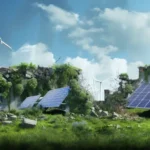Energy News Beat
It’s been obvious for many years that electricity generation from the intermittent wind and sun would never work to power a modern economy. But how would the infeasibility of the proposed energy transition finally manifest itself to put an end to the madness?
A couple of years ago I began writing about the the upcoming “Renewable Energy Wall,” for example in this piece from December 2021 titled “Which Country Or U.S. State Will Be The First To Hit The Renewable Energy Wall?” I called for readers to place their bets as to which among various jurisdictions would be the first to recognize that it could never achieve the net zero goal. But what would be the aspects of reality that would put an end to further renewable development? Would it be the soaring costs? Or perhaps the spreading blackouts? Or maybe the voters wising up? Or maybe other things that nobody had yet guessed?
Over the past few weeks and months, several parts of the coming Green Energy Wall have started to come into focus. The two factors that are emerging most significantly at this early stage are (1) voters starting to catch on, and (2) the inability of wind and solar developers to deliver projects at costs that are at all workable for consumers.
In the voter category, many places, particularly in Europe, have long had an all-party political consensus in favor of “climate action,” or some such nonsensical slogan, thus making it almost impossible for citizens to use their vote to push for any kind of sensible energy policies. But suddenly that is changing. First we had Argentina a week ago electing as President an avowed climate skeptic, Javier Milei. And then on Wednesday, the Netherlands followed suit, giving the biggest bloc of seats in its Parliament to the party of another avowed climate skeptic, Geert Wilders. Wilders’s Freedom Party delivered a drubbing to both the “center right” party of the current Prime Minister Mark Rutte, as well as to a Labor/Green coalition headed by Frans Timmermans, who is the European Commission’s Vice President and a face for the EU’s noxious climate agenda.
Euro News today has some quotes from the manifesto of the Freedom Party:
[T]he PVV manifesto . . . declares: “We have been made to fear climate change for decades… We must stop being afraid.” “The climate is always changing, for centuries,” the document goes on to say. “When conditions change we adapt. We do this through sensible water management, by raising dykes when necessary and by making room for the river. But we stop the hysterical reduction of CO2, with which, as a small country, we wrongly think we can “save” the climate.” The manifesto also calls for more oil and gas extraction from the North Sea and keeping coal and gas power stations open.
Further as to the Dutch election, here is a November 23 piece from Spiked by Fraser Myers, headlined “The Humiliation of the Dutch Establishment.” Myers makes the point that green hair-shirt energy policies have now finally made climate skepticism a winning electoral position in Europe. Excerpt:
The failure of Timmermans . . . shows that opposition to climate policy is now a significant driver of European populism. After all, as Commission vice-president, Timmermans was the face of Brussels’s stringent climate policies, including the so-called European Green Deal. The EU’s green austerity played a major role in stoking the farmers’ protests that have erupted in the Netherlands over the past few years. . . . And it’s not just agriculture that could be flattened by climate policy. As a Politicoprofile of Timmermans this week notes, the much-vaunted European Green Deal could be about to set off a wave of deindustrialisation – on a scale not seen for 50 years. Politicians who think they can get away with impoverishing their citizens, while hiding behind waffle about Net Zero, are in for a very rude awakening.
Neither Milei’s victory, nor Wilders’s, by itself means that anti-fossil fuel policies are going to disappear overnight in either country. Each of those men has far from a majority in the legislature, meaning that it will take the support of other parties to make great progress against the Green Blob. However, the process has begun.
And meanwhile the march to “green” energy, after years of uncontradicted hype, is now experiencing one reverse after another. It turns out that there are limits to how much governments can achieve by trying to hide the costs of wind and solar energy through various subsidies and tax credits. At some point, after pocketing all the subsidies and credits, the developers still must deliver power to the grid at an affordable cost; and if they can’t, they will go broke.
Just a couple of weeks ago I had a post titled “As The Transition To Green Energy Crumbles, Funding For The Climate Scare Soars.” That post had a round-up of data points in the ongoing failure of green energy to replace fossil fuels. The data points included: proposed massive off-shore wind farms off New York, New Jersey, Connecticut and Rhode Island suddenly canceled; stock prices of wind developers cratering as they can’t complete projects for agreed prices; major de-industrialization in Germany due to soaring energy prices. And the bad news for wind and solar energy, and for the “ESG” investing to fund it, only continues to get worse.
From the Wall Street Journal, November 19, “Wall Street’s ESG Craze Is Fading.” Excerpt:
Wall Street rushed to embrace sustainable investing just a few years ago. Now it is quietly closing funds or scrubbing their names after disappointing returns that have investors cashing out billions. . . . The third quarter was the first time more sustainable funds liquidated or removed ESG criteria from their investment practices than were added, according to Morningstar.
They provide this chart of the reversal of fortunes for these so-called “sustainable” funds:
Without private investors, the wind and solar future becomes 100% dependent on government handouts. At some point, those can’t continue either.
And from Canada’s Financial Post, November 17, by venture capital investor Henry Geraedts, “Net-zero policies colliding with economic reality.” Excerpt:
Renewables aren’t reliable and many companies are discovering they don’t pay for themselves even with unsustainably high subsidies. . . . The inconvenient truth is that the clean energy transition is not unfolding as foretold. Three decades and trillions of dollars in subsidies later, wind and solar still represent single-digit percentages of global energy demand, which continues to grow. . . . Our governments holding forth sanctimoniously about imagined climate-driven severe weather events while imposing large-scale use of wind and solar is insanity with serious consequences.
The best thing to end the wind/solar craziness will be to have one or two jurisdictions fail spectacularly as a lesson to everyone else. I wouldn’t have wanted my own New York to volunteer for that role, but that may be what’s happening.
The post The Green Energy Wall Gradually Coming Into Focus appeared first on Energy News Beat.








